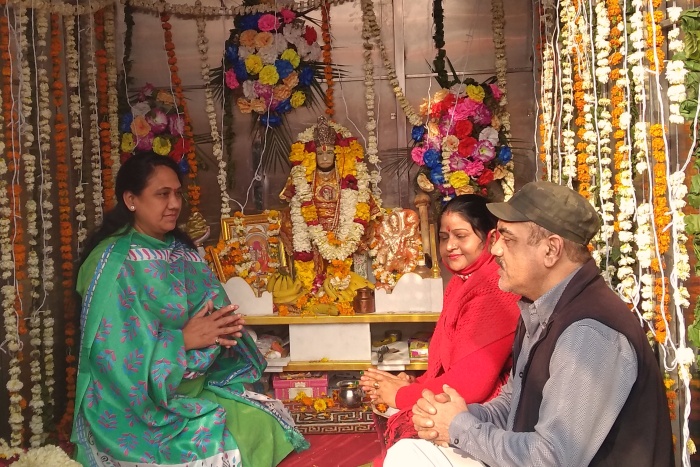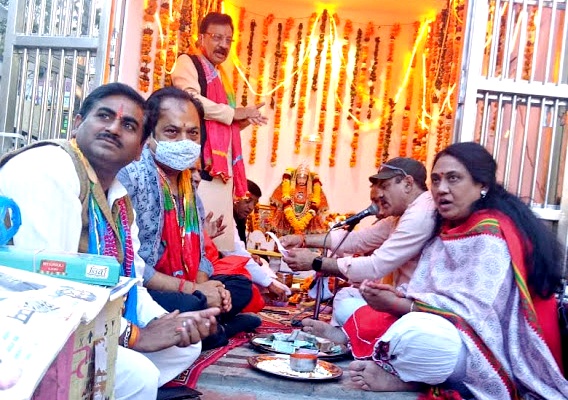Women Empowerment: A Long Way to Go
Women Empowerment and Gender Equality is still a distant dream for women in many parts of the world.

It was a conflict between the State and its citizens, one rooted in the structures of an administration, insensitive to the needs of its people.
In the early hours of January 3rd, 2021, a decades old Hindu Temple was demolished leaving devotees heartbroken and defeated. The peaceful and non-violent manner in which the people of the area succeeded in rebuilding their Temple is a story worth telling.
There was a very old Hindu Temple on the main road of Chandni Chowk, a town located in the heart of Delhi, the capital city of India. The Hanuman Temple was so small, it did not have an authorized Trust or anyone who owned it, but it was a place where local residents and shopkeepers alike prayed each and every day.
Chandni Chowk is a 400-year old neighborhood, mostly run down and in poor condition, but a comfortable place that Kenu Agarwal, President of the Representatives of Chandni Chowk Unit of Sanskar Bharti calls home.
When the government created a redevelopment plan for the beautification of the area and to alleviate some of the traffic, all the buildings were retained except for the little Temple. The State had omitted to invite the community when designing its plans and officials did not realize the significance of the Hanuman Temple when deciding what to destroy. Because the Temple didn't have a legal owner it was considered an unauthorized construction. Once the plans were approved, the courts ordered its demolition.
Devastated by the news, Kenu joined other residents and local businesses to try to resist the demolition by sitting on the road outside the Temple every time the authorities came there to try to demolish it.
The rows of toilets on the side of road were bigger than the Temple, so why couldn’t authorities approve a small Temple being part of the redevelopment plan?

Each time, officials had to turn back.
The Temple Priest would call his worshippers for help every time he would be notified that the demolition crew would come. Each time, large groups of people would come to protect the little Temple. Protestors remained friendly towards the authorities, at the request of local leaders.
The campaign called “Save the Temple” created waves that reached all the way into the Capital and other parts of the country, bringing more concerned citizens to the area. Local news reporting, social media and WhatsApp provided speedy information dissemination channels. In addition, no one person or organization brought attention to themselves and no one blamed a single authority or ministry, insead all stayed focussed on the survical of the little Temple.
Every Tuesday and Saturday prayers were held.
People pitched their tent outside the Temple and brought mattresses to sleep on. Women joined in all aspects of the demonstration, but typically only until 10pm. Nighttime brings new types of risks for women, such as violence by police or youths. Although none of this happened, Kenu herself felt it more prudent to avoid spending the night at the Temple.
Politicians began blaming each other. To avoid having the attention shift, local organizations called on both parties to position themselves on the demolition of the little Temple. None could risk their voters' discontent so each party stood up in support. The police also did not want to start problems with community members, but they had to obey their hierarchy.
While the protests were happening, Kenu, leveraging her position in Sanskar Bharti and representatives from the Rudraksh Foundation and Chandni Chowk Vyapar Sangh, held talks with the authorities requesting that they do not demolish the Hanuman Temple. Local civil society leaders even went to court, but all was in vain.
Everyone eventually realized that no one wanted to destroy the Temple but it was the paperwork that kept advancing.
The bureaucracy was unable to correct the government's mistake of not checking with those impacted before making decisions.
On the evening of January 2nd, 2021, a large police force was deployed around the Temple while only a few devotees were sitting inside the sanctuary. There was such a huge police presence that no one on the outside could get near the Temple. Lots of people began gathering and their leaders were asking them to stay peaceful and non-violent. Overpowered, the few leaders and worshippers sitting inside the Temple gave way, all the while peacefully requesting that the authorities keep the God’s Idol safe and kept in a respectful manner.
In the early morning of January 3rd, the little Temple was demolished per the court's order.
In spite of the loss, peaceful demonstrations continued. The negotiations kept on going with the authorities and the police force remained to guard the demolition site. People from the whole of Delhi and different parts of India came to take part in the vigil. There were no clashes between the police and protestors because people stopped where the police would ask them to and then start to recite prayers. Prayers were being offered continuously. The message even reached high officials who came to pray.
During the talks and negotiations, the authorities identified a site far away from the original location and offered it to the Head Priest as an alternative. The local community was used to praying close to home or before opening their shops, so the residents did not agree and turned down the offer. The Priest declined the offer even though he could have been much more comfortable.
Authorities agreed that the Temple should be rebuilt and everyone wanted to help to find a solution. The power of the people made them care.
In the early morning of February 19th, 2021, the community installed a steel structure, a few feet away from the original site and placed the little Temple’s Idols of God inside the structure. After the new site was established, organizers called politicians from both parties to offer prayer which provided approval for the new Temple location.
No one had the power or the will to go against the people. From that day on devotees, residents, shopkeepers, leaders of different political parties, the Mayor, Councilors, and members of the legislative assembly, each day people came to the little Temple to offer prayers.
Soon after, the municipal corporation passed an ordinance that the new Temple should stay there. Everyone is now waiting for the Religious Committee of the Delhi Government to support the decision.

Religious and local leaders celebrated the opening of the new Temple with a meal. Kenu Agarwal (seen in the picture above on the right) was part of the worshippers who performed prayers at the reinstalled Temple. Although women are not permitted to do so, Kenu helped perform the initial rituals that took place during the first week of March, unable to ignore her contributions and having been an integral part of the campaign to rebuild the Temple. This was a great achievement for a woman of the Hindu Community.
The story of the little Temple on the main road of Chandni Chowk, is one example of the way peaceful protests can lead citizens and government to victory.
"Save Silent Valley," a social movement aimed at the protection of Silent Valley, an evergreen tropical forest in the Palakkad district of Kerala, India, is another famous example. Started in 1973 by an NGO led by school teachers and the Kerala Sastra Sahithya Parishad (KSSP), the campaign sought to save the Silent Valley from being flooded by an hydro-electric project. The valley was declared a Silent Valley National Park in 1985.
When we talk about deep democracy, we talk about a decentralized system in which the decision-making unit is only as large as is needed for the scope of those impacted by the decision to be made.
Too often, people who are not in power have to remind those who are in power that their voice matters too.
